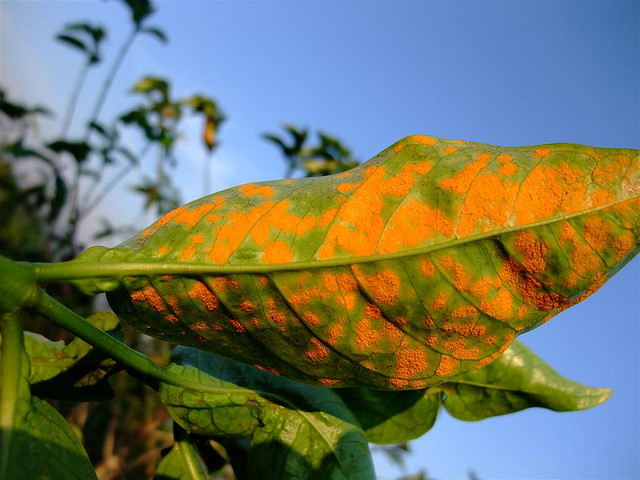Amado Gonzalez, who grows coffee on 50 acres of land in Quilali, Nueva Segovia, says he has lost almost everything this year to the plague of coffee rust (Hemileia vastatrix). Another fungus, anthracnose (Glomerella cingulata ) is affecting some areas as well. “In this harvest,” says Amado, “I could only get out 80 hundredweights (100 lbs.) when three years ago my production was 400 hundredweights and now I don’t know what to do because this is my only source of income.” He called on the government to help growers plant new coffee bushes. Replanting one acre of coffee can cost between US$3,000 and US$5,000 depending on the quality of the seed.
Nicaragua was expecting to harvest two million hundredweights of coffee this year, with a total value of US$500 million, but experts say that figure could drop by between 200,000 and 400,000 hundredweights with a corresponding loss of export earnings. Coffee generates between 300,000 and 700,000 direct and indirect jobs in Nicaragua each year. The Ministry of Agriculture reported last week that nearly 200,000 acres of coffee had been affected by the rust.
 All of Central America and part of southern Mexico have been affected by the outbreak. It rated coverage last week in Bloomberg News and on the BBC. Costa Rican President Laura Chinchilla said that her country could lose 30-40% of its harvest. Honduras has declared a phytosanitary emergency to stop the movement of the plague. Guatemalan growers said that they need US$40 million to fight the outbreak. The Salvadoran government allocated US$3 million which caused an uproar among growers who said they needed US$18 million.
All of Central America and part of southern Mexico have been affected by the outbreak. It rated coverage last week in Bloomberg News and on the BBC. Costa Rican President Laura Chinchilla said that her country could lose 30-40% of its harvest. Honduras has declared a phytosanitary emergency to stop the movement of the plague. Guatemalan growers said that they need US$40 million to fight the outbreak. The Salvadoran government allocated US$3 million which caused an uproar among growers who said they needed US$18 million.
In Managua, the Nicaraguan government and the Regional International Agricultural Sanitary Organism (OIRSA) met on January 17 and laid out a plan to combat the rust. A full survey of the extent of the problem, including mapping of affected regions, will be finished before February 15. Agriculture Minister Ariel Bucardo said that the government plan will address the crisis with phytosanitary measures, technology transfers, training, and a program to replant the coffee groves with varieties resistant to the rust. Organizations of growers and farm workers will also be strengthened. Training for the survey was scheduled to start on January 28 with government officials at the national level, who will then train those in coffee growing departments, who will then be sent to the affected zones.
At a meeting in Matagalpa, Amilcar Navarro, president of the Nicaraguan Union of Coffee Growers (UNICAFE), said that an effective plan to prevent the spreading of the rust would require at least US$12 million, while the replanting of the coffee groves could cost US$150 million and take six years. Pedro Haslam, Family Economy Minister, said that the government was seeking all the resources necessary to confront the rust plague.
While experts agree that climate change is making this outbreak more severe than those in the past, cost-driven cuts in tending the coffee bushes was also a factor in all countries, according to a BBC report. That better cared for coffee is less vulnerable, appears to be confirmed by a story in El Nuevo Diario which said that the highest grade coffee, grown at the highest elevations for a substantially higher price, has not been affected by the epidemic. As Julio Solorzano, who grows such gourmet coffee at 4,000 feet in the Department of Matagalpa, said, “We have done selective pruning, we’ve fumigated more, and that has meant we have new leaves, resistant to the rust.” Most of areas affected by the rust are below 3,000 feet.
The reports are confirmed from countries which import coffee, where markets are already feeling the consequences. Canadian direct trade coffee roasters ‘Fratello’, report on their website:
“What a terrible time to be a coffee producer in Central America. An aggressive, widespread attack of the coffee-eating roya fungus is causing more damage to Central America’s coffee plantations than was expected and is inflicting high costs on producers at a time when international coffee prices have fallen sharply.
“Just when you think it looks like coffee producers were beginning to be more profitable in their business through getting better prices for their coffee, the NY Commodity Market decides to decline sharply. Typically when you see the NYC Market go higher, you have a softening on the differential market. The opposite is then true when you see a down turn in the NYC Market. This is a stressful and risky way for coffee producers to sell coffee.
“Due to Direct Trade, our pricing remains fairly consistent year over year with the coffee producers we work with. We reward them for the quality and care they put into their coffee, typically paying 25-35% more than what Fair Trade would pay them. Through this method of working with coffee producers they are ensured they will be profitable, gives them a secured customer, gives Fratello incredible quality and takes the pressure of the NYC Market away from the producers we work with.
“All of this sounds like it gives everyone security; however, what this does not do is protect the coffee trees from environmental conditions which greatly impact the amount of coffee cherries produced each year. What we are seeing this year throughout Central America is devastating, and will impact us all for the next 2-4 years.”

